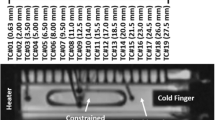Summary
In order zu simulate the motion of gas bubbles in a surrounding fluid under conditions of residual gravity in an earthbound workshop, a Hele-Shaw cell, i.e., a narrow rectangular channel filled with viscous liquid, can be utilized. Starting from the equations of creeping motion, the flow past a circular cylindrical bubble (as seen from above), located between the plates of the Hele-Shaw apparatus and surrounded by a viscous, incompressible and homogeneous fluid, has been investigated. A formula for the translational velocity of the bubble, relative to the liquid, has been derived. By employing the methods of conformal mapping noncircular (elliptical) bubble contours are taken into consideration also. The influence of surface tension at the liquid-gas interface has been dealt with approximately. Theoretical and experimental results show good agreement. The problem under study is related to the space processing of materials, especially degassing of molten matter.
Übersicht
Zur Simulation der Bewegung von Gasblasen in einer Flüssigkeit unter reduzierter Schwere kann in einem erdgebundenen Laboratorium ein Hele-Shaw Kanal verwandt werden. Die Apparatur besteht im wesentlichen aus zwei eng benachbarten rechteckigen Platten, deren Zwischenraum mit einer zähen Flüssigkeit gefüllt ist. Ausgehend von den Bewegungsgleichungen einer schleichenden Strömung wird die Umströmung einer kreiszylinderförmigen (von oben gesehen) Gasblase untersucht. Die Gasblase berühre, abgesehen von einem sehr dünnen Flüssigkeitsfilm, beide Plattenwände und sei von einer reibungsbehafteten, dichtebeständigen und homogenen Flüssigkeit umgeben. Für die Translationsbewegung der Blase relativ zur Flüssigkeit wird ein expliziter Ausdruck angegeben. Mittels konformer Abbildung lassen sich auch nicht-kreiszylinderförmige (elliptische) Blasen behandeln. Dem Einfluß der Oberflächenspannung an der Trennfläche FlüssigkeitGas wird näherungsweise Rechnung getragen. Theoretische und experimentelle Resultate zeigen gute Übereinstimmung. Das vorliegende Problem tritt auf im Zusammenhang mit verfahrenstechnischen Prozessen der Materialherstellung unter Weltraumbedingungen, insbesondere bei der Entgasung von Flüssigkeiten unter Schwerelosigkeit.
Similar content being viewed by others
References
Bredt, J. H.; Montgomery, B. O.: Materials Processing in Space Science — New Challenges for Industry. Astronautics and Aeronautics 13, 1975, No. 5, 22–41
Papazian, J. M.; Wilcox, W. R.: The Interaction of Bubbles with Solidification Interfaces. Paper 77–194, AIAA 15th Aerospace Sciences Meeting, Los Angeles, Calif. January 24–26, 1977
Bauer, H. F.; Siekmann, J.: On the Shape of a Rotating Fluid System Consisting of a Gas Bubble Enclosed in a Liquid Globe. Z. Angew. Math. Phys. 22 (1971) 532–542
Siekmann, J.; Dittrich, K.: Über die Bewegung von Gasblasen in einem rotierenden Medium. Ing.-Arch. 44 1975) 131–142
Siekmann, J.; Johann, W.: On Bubble Motion in a Rotating Liquid Under Simulated Low and Zero Gravity. Ing.-Arch. 45 (1976) 307–315
Siekmann, J.; Eck, W.: Blasenbewegung in einem Hele-Shaw-Kanal unter Einfluß eines Temperaturgradienten. Z. Flugwiss. Weltraumf. 1 (1977) 260–266
Siekmann, J.; Eck, W.; Johann, W.: Experimentelle Untersuchungen über das Verhalten von Gasblasen in einem Null-g-Simulator. Z. Flugwiss. 22 (1974) 83–92
Stong, C. L.: What Happens to the Fluid in the Tanks of Spacecraft Falling Freely in Space. Scientific American, April 1972, 106–111
Eck, W.: Blasenbewegungen zwischen parallelen, ebenen Wänden. Dissertation, Darmstadt 1975
Levich, V. G.: Physicochemical Hydrodynamics. Englewood Cliffs, N. J., 1962
Kotchin, N. J.; Kibel, I. A.; Rose, N. W.: Theoretische Hydrodynamik. Band I, Berlin 1954
Fritz, G.: Bestimmung der Zähigkeit von Polyphenylen mit Hilfe einer Methode für kleine Substanzmengen. Bericht der EURATOM, EUR 594 d (1964)
Friz, G.: Über den dynamischen Randwinkel der vollständigen Benetzung. Z. Angew. Phys. 19 (1965) 374–378
Coney, A.; Masica, W. J.: Effect of Flow Rate on the Dynamic Contact Angle for Wetting Liquids. NASA-TND-5115, 1969
Prutow, R. J.; Ostrach, S.: A Hydrodynamic Model of Dynamic Contact Angle Hysteresis. AFOSR Sci. Rep. No. 70-2882 TR, FTASITR-70–56, 1971
Siekmann, J.; Eck, W.; Johann, W.: On Bubble Motion Through Liquid Under Reduced Gravity. Arch. Mechanics 28 (1976) pp. 795–801
Siekmann, J.; Eck, W.: Analytische Bestimmung der ebenen Trennfläche eines zwischen planparallelen horizontalen Wänden eingeschlossenen Systems Flüssigkeit-Gas. Acta Mech. 25 (1977) 285–290
Author information
Authors and Affiliations
Rights and permissions
About this article
Cite this article
Eck, W., Siekmann, J. On bubble motion in a Hele-Shaw cell, a possibility to study two-phase flows under reduced gravity. Ing. arch 47, 153–168 (1978). https://doi.org/10.1007/BF01047407
Received:
Issue Date:
DOI: https://doi.org/10.1007/BF01047407



